MAYBE THIS IS WHAT IT LOOKS LIKE ON THE MOON
Tuesday, September 13, 2016
 Nevsehir, Cappadocia, Turkey
Nevsehir, Cappadocia, Turkey
September 13 … .Are we in a Fairytale???
After taking a 6:15 a.m. flight to Neveshir, Cappadocia, we arrived at 7:35 a.m. and were met by our tour guide, Salim and our driver, Haga. Once again, we assumed that we would be part of a group tour but, possibly because of the decline in tourism, it was just the two of us on what turned out to be a private tour. My fabulous travel expert had done it again…finding us an amazing, incredibly reasonable, tour with a guide who spoke beautiful English, had a sense of humor and was unbelievably knowledgeable as well.
Shortly after leaving the airport, it felt like we were driving straight into a whimsical fairytale, set upon the stark Anatolian plains of Cappadocia. Ancient volcanic eruptions, dating back 2 million years, blanketed this region with thick ash, which solidified into a soft rock called tuff, 150 meters thick. After the volcanic eruptions, during the Ice Age, Cappadocia was under water. Then, thousands of years of erosion of the lava covered plains, by wind and water, left only the harder elements behind to form a fairy tale landscape of cones, pillars and pinnacles . The mushroom shaped cones, soaring as high as 40 meters into the sky, are comprised of ash below and darker basalt on top, and are referred to by the locals as fairy chimneys. To us, they looked like oversized hobbit houses.
Salim took us to several expansive areas filled with these fantastic formations, stopping on the way for a light breakfast of Turkish pancakes, coffee and fruit. According to Salim, in addition to the major sites, he would be taking us to areas that other tour companies rarely take their clients. It was, truly, an experience of a life time to be able to walk and climb for hours through these towering, odd formations without another tourist in sight.
While the forces of nature initially shaped this incredible landscape, we saw how human hands performed equally incredible transformations at our next stop. Salim guided us through many of the formations that had been carved into by the Hittites, ancient ancestors to the Turks, who established a powerful empire in Asia Minor and Syria and who were dominant from about 2000 to 1200 BC . By tunneling into the rock, they created thousands of cave dwellings and pigeon houses. The pigeons were used for sending messages to other villages and, during battles with their enemies, the pigeon droppings were used for gun powder. The Hittites also created places of pagan worship which would, hundreds of years later, be converted into churches by the early Christians. The nomadic Hittites used the Red River, the longest river in Turkey with a length of 1,450 km, for trading with Mesopotamia, Tigress and Euphrates. They also created the cuneiform script, the oldest form of written language, examples of which we saw at the Archaeology Museum in Istanbul.
We stopped for lunch at a tiny outdoor restaurant, owned by friends of Salim, and were served traditional Turkish food, accompanied by numerous small bowls filled with different sauces and spices. Not only was it delicious but it was also beautifully prepared. After lunch, we went to a coop where magnificent Turkish carpets were hand woven. We were given a demonstration of how different fruits and plants are used to create the various colors of the wool as well as a demonstration of the actual weaving.
Then we saw how the threads, used for weaving the silk carpets, are created. The single strand that the silk worm produces to make its cocoon is about one mile long. When the cocoon is unwound, it can be separated into about 20 to 25 strands . Then, approximately 450 to 500 of these finer strands are wound together to make a single thread, thousands of which are used to weave the silk carpets. After seeing this process, it's easy to understand why silk carpets are so expensive. I sure would love to have one of these pieces of art…maybe if I win the lottery. We also learned that the Turkish government subsidizes the coop and the 2000 women who work there and, because of how intense the weaving is and how hard it is on their eyes and back, they are only allowed to work 6 hours a day.
After the demonstrations, they gave us the dog and pony show, rolling out one gorgeous carpet after another in hopes that we would be tempted to make a purchase, particularly since they would start at a high price then, of course, end up at a price less than half of the original quote. You just have to wonder……
Next we went to an area called Soganli and hiked up to another whole community of cave dwellings and found it so interesting to learn the logic behind how these dwellings were constructed . In all of the ones we went into, the stables and kitchens were always on the first floor so that the heat from the animals, as well as the fires used for cooking, provided warmth to the bedrooms that were located directly below the kitchen and stables. Salim also took us into some incredible churches, originally pagan but now Christian. The Karabas Church, in particular, had beautifully preserved frescoes from the 10th and 11th centuries. We noticed that there was a lot of graffiti on the walls but, upon closer inspection of the dates, we learned that the inscriptions were made by the Greek Orthodox who, for hundreds of years, have come to Cappadocia on pilgrimages to write their blessings on the walls of these sacred churches.
On every tour we’ve taken, the guides always give the tourists the opportunity to purchase whatever a particular country or area is known for, in hopes of earning a commission, I’m sure. This tour was no exception as we stopped at a huge jewelry manufacturer that specialized in green onyx, turquoise and a stone, I’d never heard of before, called Zultanite . Although mines have been discovered in a few other parts of the world, Cappadocia is the only place where gem stone quality stones are found. Before we arrived, Salim had told us about this unusual stone that, depending on the light, can display five different colors…green, brown, yellow, rose and pink. I was fascinated and, when I spotted one beautiful and simple square cut stone, set in silver, I was hooked. I guess Bill was too, as he bought it for me!!! I love my new ring, even more so as it will always remind me of this special visit to Cappadocia.
Our next stop was Derinkuyu, the largest excavated underground city in Turkey. It is believed that the Hittites were the first to start carving this underground city, 4,000 years ago, to find protection from the persecution of Ramses II, who was trying to conquer Cappadocia.
Derinkuyu, extending to a depth of 200 feet, has 600 entrances, many miles of tunnels connecting it to other underground cities, and can accommodate more than 20,000 people . It truly is an underground city, with areas for sleeping, stables for livestock, wells, water tanks, wineries, pits for cooking, ventilation shafts, communication holes between the levels, that also served to alert the community of impeding danger, communal kitchens and meeting areas, bathrooms, places of worship and tombs. We were amazed when Salim told us that this massive underground city was discovered as recently as 1965 by a farmer who found one of the ventilation holes and notified the government. Although Derinkuyu is the largest, there have been more than forty complete underground cities and 200 underground structures discovered in the Cappadocia region, many of them connecting to each other via tunnels.
As we wandered through the dark passageways, Salim gave us more history, telling us that when the Hittites started carving this city, they would take the dirt out through small holes, a little at a time, and carry it to the Red River so there would be no evidence above ground for Ramses to detect what they were doing . They got most of their water from underground springs as Ramses would poison the water sources above ground.
Most people didn’t live in the underground cities full time. There was a vast network of tunnels, connecting each home in the area above to the city below so, when the area came under attack, families would flee to their basements, rush through the dark tunnels, and gather in the underground city.
We passed by many traps laid throughout the labyrinth of corridors, such as holes in the ceilings through which spears could be dropped on the invaders and huge round stone doors, some weighing as much as 2,000 kilos and 35 meters in diameter. It took 10 men to roll the stones over the oil, applied to the floor, to block the doorways so that each floor could be closed off separately. The construction of this city passed from one generation of Hittites to another for 350 years. It is known that most of the lower levels were dug out later by early Christians to provide them with refuge from persecution…first during Roman times, and later from invading Arabs . These Christian builders further outwitted their invaders by making the tunnels narrow, forcing their enemies to fight, and be picked off, one by one.
Salim gave us so much more fascinating information that would take pages to convey. We had been completely awed by having seen one of the most spectacular landscapes in the world. We had learned that cities, empires, and religions have risen and fallen around these unique underground havens. Through the ages, the Hittites, Persians, Alexander the Great, Rome, The Byzantine Empire, Ottoman Empire and Turkey have all governed the amazing region of Cappadocia. These one hundred square miles, with more than 200 underground villages and tunnel towns complete with hidden passages, secret rooms and ancient temples and a remarkable history of each new civilization building on the works of the last, make Cappadocia one of the world’s most striking and largest cave-dwelling regions of the world. Then, Salim gave us one final bit of information that was really a mind blower…Apparently, a recent discovery had been made. Archaeologists in Turkey have uncovered another massive underground city in Cappadocia, large enough to house 50,000 dwellers. It reportedly consists of at least 7 kilometers of tunnels, hidden churches, and escape galleries dating back around 5,000 years. I guess we’ll have to return to Cappadocia when they’ve finished the excavation….if we’re still alive.
Other Entries
Comments
2025-05-22
Comment code: Ask author if the code is blank

 Nevsehir, Cappadocia, Turkey
Nevsehir, Cappadocia, Turkey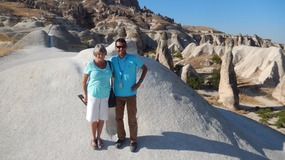
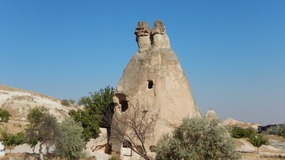

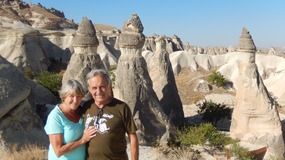
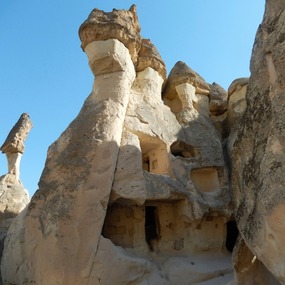
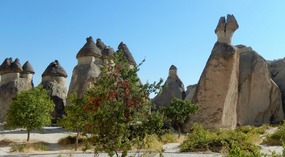
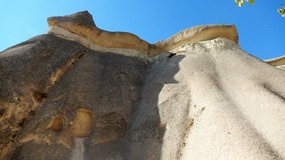
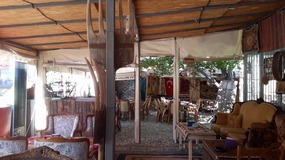
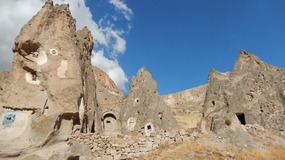






















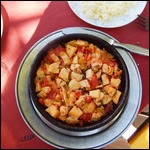
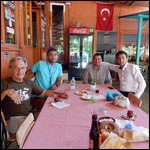


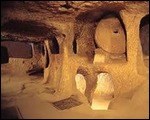

amanda2-15
2016-10-30
What an interesting part of your trip, Susan!
Kate
2016-10-30
I loved Cappadoccia and all the history that I guess I'd heard from the bible. What? I read the bible? Somehow, I'd sure heard about the Hittites. Movies, maybe. I wonder if your underground city is the one we saw. We did see a round door, so clever to keep the bad guys out. I think we had lunch in Nevsehir.
Pastricks
2016-10-30
Excellent and interesting. Thanks for sharing this amazing piece of history
Richard Taylor
2016-10-30
Looks like a great trip!
Priscilla
2016-11-05
How fabulous..you 2 are amazing..what a coup..of a tour